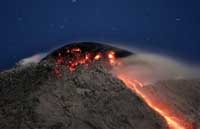Concrete balls successfully dropped into Indonesian mud volcano
Indonesian engineers successfully dropped several large concrete balls into an erupting mud volcano on Monday to try and stem a sea of sediment that has engulfed hundreds of homes, factories and fields and left 11,000 people homeless.

Over the next few weeks, authorities plan to drop nearly 1,500 balls, weighing up to 40 kilograms (88 pounds) each, into the crater that started spewing mud at a gas drilling field in east Java nine months ago.
"I am very happy with what we have achieved today," said Satria Bijaksana, the geologist in charge of the operation, which is believed to have never been tried before.
The team hopes the balls will gradually reduce the amount of mud flowing from a gash in the earth by up to 70 percent by absorbing some of the volcano's energy. The mud is now surging out at a rate equivalent to about a million oil drums a day.
On Monday, 16 balls were hoisted above the crater on a pulley before being dropped from a height of 5 meters (5.47 yards). Bijaksana said 16 balls by themselves were not enough to cause a noticeable reduction in the mud flow. The team will monitor the effects before dropping more balls Tuesday.
Critics have said they fear the experiment may cause the mud to flow from different points in the gas field.
The experiment has been repeatedly delayed. On Saturday, engineers were forced to abandon work when the steel cable hoisting the balls broke.
Mud volcanos are fairly common along volatile tectonic belts such as the one running below Indonesia, and in areas where there are rich oil and natural gas deposits.
Opinions differ about the cause of the mud flow, but experts agree it could continue for years, reports AP.
Some scientists suggest the rupture was triggered by faulty gas exploration techniques by operator PT Lapindo Brantas. Other research suggests it is the result of increased seismic activity, with the mud flow starting two days after a major earthquake elsewhere on Java island.
Some of the mud is being channeled to the sea, while the rest is being contained behind dams.
Subscribe to Pravda.Ru Telegram channel, Facebook, RSS!


